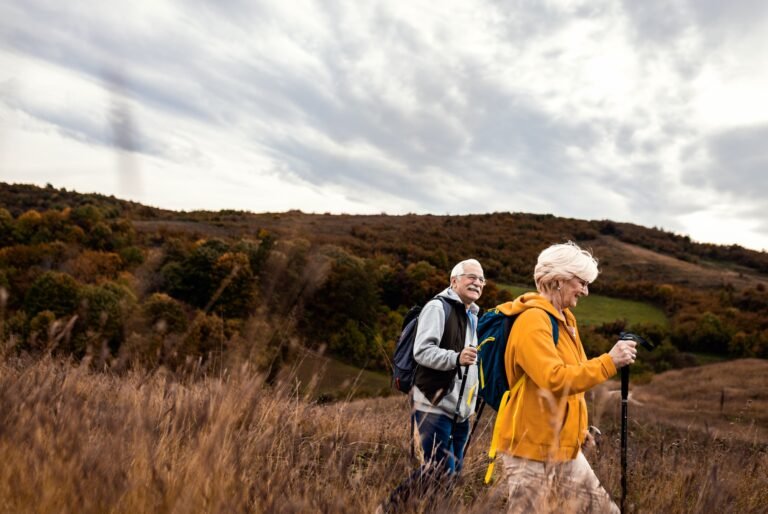Staying active and independent is important at any age. For many seniors, getting out of the house to walk, shop, visit friends, or attend appointments is part of daily life. But being away from home can bring a certain amount of risk, especially if a medical issue or unexpected accident happens. In these moments, having a way to quickly connect with help can make all the difference.
When a person knows that help is available at the press of a button, they can move through the day with less worry. For seniors, this isn’t just about convenience—it’s about safety, confidence, and maintaining independence.
The Challenges Seniors Face When Away From Home
As people age, certain changes can make emergencies more likely. Balance may not be as strong, vision may be less sharp, and reaction times may slow down. Even healthy, active seniors can face sudden problems such as dizziness, falls, or chest discomfort.
Being at home often means a phone is within easy reach. Outside the home, that’s not always the case. A senior may be walking in a park, riding in a friend’s car, or shopping at a busy store. If something happens, it can be hard to reach a phone quickly—or even to explain where help is needed.
This is where having a reliable safety device can be life-saving. A small, wearable alert can be used instantly without searching through a bag or pocket. It can also give first responders accurate location details, even if the person is unable to speak.
Technology That Puts Safety First
Modern safety devices for seniors are designed to work anywhere, not just inside the house. These systems can connect to trained response teams in seconds, providing support until emergency services arrive.
One example is the Life Assure mobile medical alert. It’s a lightweight device that can be worn as a pendant or clipped to clothing. If an emergency happens, the user presses the button, and help is on the way—whether they are at home, in the yard, or miles away in another town. Many of these devices also include GPS, which means help can be sent exactly where it’s needed.
This type of technology is changing how families think about safety. Instead of feeling limited to the safety of home, seniors can continue doing what they enjoy, knowing they have protection everywhere they go.
Why Staying Connected Builds Confidence
Safety devices do more than just provide a way to call for help—they build confidence. For seniors, this means being able to enjoy walks, visit markets, or travel to see family without worrying about “what if” scenarios.
When confidence grows, activity levels often do as well. This can lead to better overall health, both physically and emotionally. Regular movement helps keep joints flexible, muscles strong, and the mind sharp. Social interaction can also reduce feelings of loneliness, which is a common issue among older adults.
Family members benefit too. Knowing their loved one has a direct line to help can reduce anxiety and prevent the urge to constantly check in. This balance allows seniors to keep their independence while giving families peace of mind.
A Quick Response Can Save Lives
In emergencies, minutes matter. Whether it’s a fall, a heart issue, or another sudden medical event, the faster help arrives, the better the outcome is likely to be. Mobile alert systems connect to trained operators who can immediately send medical assistance.
This quick response is especially important for falls, which are a leading cause of injury for older adults. If a senior falls and can’t get up, being able to call for help without moving can prevent further injury and ensure they receive care quickly.
Some devices even have fall detection features, which automatically alert help if a fall is detected and the wearer can’t press the button. While not every device has this, it’s an option worth considering for those with higher fall risks.
Making the Right Choice
Not every safety device is the same. Some have longer battery life, while others focus on features such as waterproof designs for use in the shower. When choosing a system, it’s important to think about daily routines and where the device will be used most.
A senior who spends a lot of time gardening might need something durable and weather-resistant. Someone who enjoys visiting friends across town may want a device with strong GPS tracking and wide coverage. Comfort also matters—if a device is heavy or awkward, it’s less likely to be worn regularly.
Cost is another factor. Some services charge a monthly monitoring fee, while others are prepaid. Families should compare options carefully and choose one that fits both needs and budget.
Encouraging Seniors to Use Safety Devices
Sometimes, older adults are hesitant to wear a safety device. They may think it makes them look frail or that they won’t actually need it. Open conversations can help. Instead of focusing on “what could go wrong,” it’s better to talk about freedom, independence, and peace of mind.
Sharing real examples—such as how a friend got quick help after slipping in a parking lot—can make the value of these devices easier to understand. Trying the device at home first can also help build comfort before using it while out and about.
A Step Toward Safer, More Independent Living
For seniors who enjoy staying active, a mobile safety device is a smart choice. It allows them to keep living life on their own terms while staying connected to help at all times. This connection doesn’t take away independence—it protects it. The real benefit is knowing that no matter where a senior goes, they’re not alone in an emergency. Whether walking the dog, shopping for groceries, or visiting family, help is just one button away. That peace of mind can be life-changing, both for seniors and for the people who care about


































